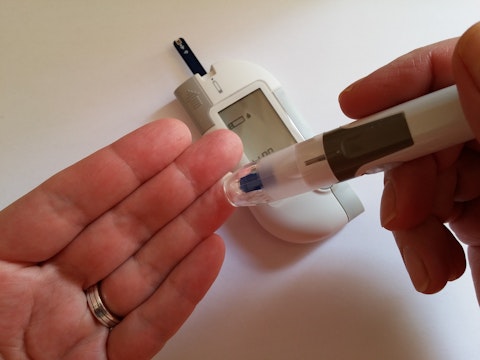In this article, we will be taking a look at the 20 countries with the highest rate of diabetes. If you are not interested in reading the details about companies developing treatments for diabetes, you can head straight to the 5 Countries With The Highest Rate Of Diabetes.
Diabetes, a chronic metabolic disorder, has become a pressing global health concern, affecting millions worldwide. Among the numerous nations grappling with this epidemic, some nations like Pakistan, China, and India stand out among the top 10 countries with diabetes in in the world due to their alarmingly high rates of diabetes. These countries bear the burden of not only the physical and emotional toll on their citizens but also the economic strain on healthcare systems.
Exploring the countries with the highest prevalence of diabetes sheds light on the complex interplay of factors, such as lifestyle changes, genetic predispositions, and healthcare accessibility, that contribute to the rising prevalence of this condition. Understanding the challenges these nations face can pave the way for targeted interventions and international collaborations to mitigate the impact of diabetes on a global scale.
The Diabetes Pandemic: Understanding the Global Prevalence
Diabetes has become a significant health concern all over the world. It is estimated that over 400 million people are living with diabetes worldwide, and this number is expected to rise to 700 million by 2045. The prevalence of diabetes varies by region, with some countries experiencing much higher rates than others. In developed countries, most diabetes is generally higher than in developing countries. In the United States, for example, nearly 10% of the population has diabetes.
Type 2 diabetes accounts for the vast majority of diabetes cases worldwide. This type of diabetes is often associated with lifestyle factors such as poor diet and lack of exercise. However, genetics also play a role in developing type 2 diabetes. Many complications are associated with diabetes, including heart disease, kidney disease, and nerve damage. It is essential to manage diabetes effectively to prevent these complications from occurring.
Pharmaceutical Market Insights: Diabetes Treatments in High-Risk Nations
Diabetes is a growing concern in many high-risk nations, and the pharmaceutical market is constantly evolving to meet the demand for effective treatments. According to recent financial statistics, the global diabetes market was valued at $59.93 billion in 2020, projected to reach $103.85 billion by 2027. With advancements in technology and research, more options are available for those living with diabetes than ever before.
Several companies are working tirelessly to find a cure for diabetes. One such company is Novo Nordisk A/S (NYSE:NVO), which has developed several drugs, including Victoza, a once-daily injection for type 2 diabetes. Another company making strides in diabetes treatment is Sanofi (NASDAQ:SNY), which has developed the drug Lantus, a long-acting insulin used to regulate blood sugar levels.
Eli Lilly and Company (NYSE:LLY), one of the most profitable pharmaceutical companies in the world, is also a significant player in diabetes treatment with their drug Humalog, a fast-acting insulin used to control high blood sugar. These companies, and many others, are dedicated to improving the lives of those with diabetes and finding a cure for this debilitating disease.
However, it is essential to note that access to these treatments may be limited in certain areas, and many challenges remain to be addressed in providing equitable healthcare for all individuals. By staying informed on the latest market insights and advocating for improved access to diabetes treatments, we can work towards a healthier future for all.
Insulin Prices in the USA: A Growing Concern for Diabetics
The cost of insulin in the USA has increased by over 600% in the past two decades. As a result, nearly one in four Americans with diabetes have reported rationing their insulin due to the high cost, which can have serious and even life-threatening consequences. However, by investing in more affordable insulin options, such as biosimilars and generic versions, the biggest pharmaceutical companies in the world like Sanofi (NASDAQ:SNY), Eli Lilly and Company (NYSE:LLY), and Novo Nordisk A/S (NYSE:NVO), among others, can help reduce the financial burden on patients and the healthcare system as a whole.
According to a report, the cost of treating diabetes in the USA was $16,752 per person annually, with insulin accounting for a significant portion of that cost. By making insulin more accessible and affordable, we can not only improve the health outcomes of those living with diabetes, but also create a more sustainable and cost-effective healthcare system.
Collaborative Initiatives: Public-Private Partnerships for Combating Diabetes in Affected Nations.
Collaborative initiatives between the public and private sectors are crucial for combating diabetes in affected nations. The financial burden of diabetes is also significant, with global healthcare spending on diabetes reaching $727 billion in 2017. Public-private partnerships can bring together the necessary resources and expertise to address this growing problem, including access to affordable healthcare, education, awareness programs, and research and development of new treatments. By working together, we can significantly impact the lives of those affected by diabetes and help create a healthier future for all.

Pixabay/Public Domain
Our Methodology
For our methodology, we have ranked countries with the highest rate of diabetes as of 2021 in ascending order. For the accuracy of the data, we relied on World Bank’s 2021 report on Diabetes, which revealed the percentage of countries’ populations aged 20-79 years suffering from diabetes.
Here is our list of the 20 countries with the highest rate of diabetes.
20. Mexico
Diabetes Rate: 16.9%
Mexico is facing a significant health challenge, with the highest rate of diabetes among OECD countries. Approximately 16.9% of the Mexican population of ages 20-79 suffer from this disease. The age group most affected is between 45 and 64, but cases are also rising among younger people. The impact is significant, straining the healthcare system and economy, costing around $5 billion annually. Indirect costs, like lost productivity and reduced workforce participation, further exacerbate the situation. Urgent action is needed to implement effective prevention and management strategies to address this growing concern.
19. Palau
Diabetes Rate: 17%
Around 17% of Palau’s population in the age group 20-79 currently suffers from diabetes, with a notable increase in middle-aged and elderly individuals. The negative symptoms of fatigue, blurred vision, and frequent urination impact those diagnosed with diabetes. The economic strain is evident due to the rising cost of treatment. The Palau Ministry of Health is actively promoting awareness and supporting research for more effective treatments and prevention measures. The urgency to address this issue is emphasized by the financial statistics surrounding the cost of diabetes management.
18. Fiji
Diabetes Rate: 17.7%
Diabetes poses a growing concern in Fiji, impacting around 1 in 3 adults, with higher prevalence across all age groups in urban areas. The disease’s complications, such as kidney disease, blindness, and amputations, carry significant risks. The Fijian government has taken steps to combat the epidemic, promoting healthy lifestyles, exercise, and access to education and treatment. As per the data, healthcare expenditure for diabetes in Fiji reached 24.4 million U.S. dollars in 2017, with an average cost of 298 U.S. dollars per diabetes patient last year.
17. Saudi Arabia
Diabetes Rate: 18.7%
Saudi Arabia is one of the most diabetic countries in the world. Diabetes in the country impacts nearly 19% of the adult population, and costing the healthcare system around 17 billion Saudi riyals annually. The disease affects individuals between 20 to 79 year olds, and there is a concerning rise in young adults and children being diagnosed. Nonetheless, the government proactively addresses the issue, invests in research, increases public awareness campaigns, and improves access to diabetes care and education.
16. Sudan
Diabetes Rate: 18.9%
Just like other countries, diabetes is a serious issue in Sudan, affecting approximately 18.9% of the adult population between the age group of 20-79 years, with a higher prevalence in older age groups. Healthcare costs are substantial, with a total healthcare expenditure of 3.02% of GDP in 2020. Efforts to improve the situation include
- raising public awareness,
- enhancing access to diabetes care, and
- investing in research for better treatments.
The growing market for diabetes-related products and services offers promising opportunities for local and international companies to meet the increasing demand for diabetes care in Sudan.
15. Malaysia
Diabetes Rate: 19%
Around 3.6 million people in Malaysia, primarily those aged 40 and above are affected by diabetes. Complications like kidney failure and heart disease have severe impacts on individuals. The government is taking steps to combat diabetes by increasing public awareness, improving healthcare access, and promoting healthier lifestyles. Managing diabetes through healthy habits can improve quality of life and reduce complications.
14. Guam
Diabetes Rate: 19.1%
Diabetes is a severe issue in Guam, affecting around 19.1% of the population aged 20-79 years. It poses significant health risks, leading to complications like heart disease and kidney failure, while imposing a high economic cost to combat this issue, efforts are underway to increase public awareness, promote healthy lifestyles, provide affordable healthcare, and conduct vital research for better prevention and treatment strategies.
13. Qatar
Diabetes Rate: 19.5%
Diabetes imposes a significant financial burden on Qatar’s economy, with an estimated healthcare cost of $2,180 per patient in 2020. Leading pharmaceutical companies, such as Novo Nordisk A/S (NYSE:NVO), Sanofi (NASDAQ:SNY), Eli Lilly and Company (NYSE:LLY), and Merck, are investing in the Qatari diabetes market to cater to the increasing awareness of the condition, rising obesity rates, and an aging population.
12. Soloman Islands
Diabetes Rate: 19.8%
Solomon Islands also stands among the countries with the highest rate of diabetes, affecting around 19.8% of the population aged 20-79 years, with the majority being individuals over 40. In 2020, health expenditure in the Solomon Islands accounted for 4.4% of the country’s GDP in 2020, highlighting the evident economic burden caused by healthcare costs, including those associated with diabetes management and treatment. However, the government and healthcare organizations are taking action, promoting healthy lifestyles and improving access to screenings and treatments to reduce the financial burden and improve outcomes for those affected.
11. Tuvalu
Diabetes Rate: 20.3%
Approximately 20% of Tuvalu’s population is affected by diabetes, with higher rates among the elderly. The disease also impacts productivity and economic growth. The government is increasing public awareness, providing access to affordable healthcare, and promoting healthier lifestyles to combat the growing diabetes epidemic.
10. American Samoa
Diabetes Rate: 20.3%
Diabetes is a primary concern in American Samoa, affecting over 20% of adults aged 20-79 years, particularly those aged 45 and above, with a higher prevalence among women. The disease leads to complications, reduced productivity, and increased healthcare costs, impacting the local economy, especially the service industry. Authorities are raising awareness and improving access to healthcare and treatments to address the issue and enhance well-being.
9. Egypt
Diabetes Rate: 20.9%
Egypt, one of the top countries with diabetes in world, has around 20.9% of its population aged 20-79 years affected by this disease across various age groups as of 2021. The financial impact is substantial, with an estimated healthcare expenditure of 4.36% of GDP as of 2020. Older age groups, particularly those over 60, have a higher prevalence of diabetes.
8. Kiribati
Diabetes Rate: 22.1%
Kiribati stands eighth among the countries with the highest rate of diabetes, with 22% of its population aged 20-79 years, primarily middle-aged and older, affected by the condition. The financial impact is substantial, with healthcare costing about 11.6% of GDP in 2020, burdening the healthcare system and the economy. Complications like heart disease and kidney failure increase healthcare costs and reduce productivity. The government addresses the issue, promotes healthy lifestyles, and improves healthcare access.
7. Mauritius
Diabetes Rate: 22.6%
Diabetes is a growing concern in Mauritius, with a higher prevalence among older adults. The economic impact is substantial, with the healthcare expenditure costing around 6.66% of the country’s GDP in 2020. To combat this, Mauritius has implemented measures such as public awareness campaigns, access to diabetes screening, and promoting healthy lifestyle habits.
6. Marshall Islands
Diabetes Rate: 23%
Diabetes impacts almost a third of the adult population in Marshall Islands. Complications such as blindness and kidney failure can be life-threatening. The economic impact is significant, with healthcare costs equivalent to 13.1% of the country’s GDP in 2020. To address the issue, the government is promoting healthy lifestyles and investing in healthcare infrastructure for improved diabetes care and management.
Click to see and continue reading the 5 Countries With The Highest Rate Of Diabetes.
Suggested Articles:
- 20 Countries with the Highest Rate of Dementia
- 30 Countries With Highest Rates of Population Growth
- Top 20 African Countries with the Highest White Population
Disclosure. None: 20 Countries With The Highest Rate Of Diabetes is originally published on Insider Monkey.





